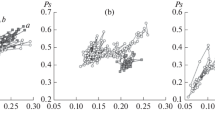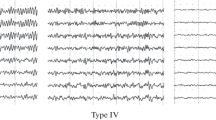Studies of 12 subjects using Fourier analysis addressed the EEG amplitude-frequency spectrum at a constant level of normobaric hypoxia (breathing an oxygen-nitrogen mix containing 8% oxygen for 25 min). Cluster analysis of the 16-channel EEG identified two groups of subjects differing in terms of relative spectral power (SP) in the EEG δ range averaged over the period of hypoxia. Six of the subjects of the group 1 (n = 7), with greater relative SP in the δ range during hypoxia showed dominance o δ activity in all subsequent 1-min segments and all leads starting after 6 min of hypoxia. Subjects of group 2 (n = 5) showed dominant α activity in the occipital leads overall for the 25 min of hypoxia. In sequential 1-min segments, the dominance of α activity in some subjects of this group changed to a dominance of δ and θ activity. These studies showed that the dynamics of the EEG amplitude-frequency spectrum at a constant level of hypoxia do not always correspond to sequential “slowing” of the EEG described in increasing hypoxia.
Similar content being viewed by others
References
E. A. Burykh and S. I. Soroko, “Reflection of the reserve capacities for compensation of oxygen deficit in the dynamics of brain blood flow in acute hypoxia in humans,” Ros. Fiziol. Zh., 100, No. 11, 1310–1323 (2014).
A. M. Gurvich, Electrical Activity in the Dying and Surviving Brain, Meditsina, Leningrad (1966).
A. M. Dudchenko and L. D. Luk’yanova, “The trigger role of energy metabolism in the cascade of functional metabolic impairments in hypoxia,” in: Challenges of Hypoxia: Molecular, Physiotherapy, and Medical Aspects, L. C. Luk’yanova and I. B. Ushakov (eds.), Istoki, Moscow (2004), pp. 51–83.
V. A. Zabolotnykh, V. N. Komantsev, and A. G. Povorinskii, A Practical Course in Classical Clinical Electroencephalography, Nauka, St. Petersburg (1998).
E. A. Kovalenko and I. N. Chernyakov, “Tissue oxygen in extreme flight factors,” in: Challenges in Cosmic Biology, Nauka, Moscow (1972), Vol. 21.
V. B. Malkin and E. B. Gippenreiter, Acute and Chronic Hypoxia, Nauka, Moscow (1977).
A. Yu. Malyshev, L. D. Luk’yanova, and S. V. Krapivin, “The action of hypoxia of increasing severity on EEG dynamics in the cerebral cortex of rats with different resistance to acute oxygen deficit,” Byull. Eksperim. Biol. Med., 9, 262–267 (1996).
I. R. Petrov, The Role of the Central Nervous System, Adenohypophysis, and Adrenal Cortex in Oxygen Deficit, Meditsina, Leningrad (1967).
S. I. Soroko, S. S. Bekshaev, and V. P. Rozhkov, “’EEG markers’ of impairments to systems activity in the brain in hypoxia,” Ros. Fiziol. Zh., 94, No. 5, 481–501 (2008).
“Terminological guidelines (dictionary of terms used in electroencephalography,” Fiziol. Cheloveka, 4, No. 5, 936–954 (1978).
V. Yu. Urbakh, Statistical Analysis in Biological and Medical Research, Meditsina, Moscow (1975).
D. G. Cook, R. M. Wells, and N. A. Herbert, “Anaemia adjusts the aerobic physiology of snapper (Pagrus auratus) and modulates hypoxia avoidance behaviour during oxygen choice presentations,” J. Exp. Biol., 214, No. 17, 2927–2934 (2011).
H. Gastaut, H. Fischgold, and J. H. Meyer, “Conclusions of the international colloquium on anoxia and the EEG,” in: Cerebral Anoxia and Electroencephalogram, H. Gastaut and J. Meyer (eds.), Springfield (1961), pp. 599–617.
A. Kumar and R. Goyal, “Possible GABAergic modulation in the protective effect of zolpidem in acute hypoxic stress-induced behavior alterations and oxidative damage,” Neurochem. Res., 33, No. 3, 370–377 (2008).
J. S. Meyer, K. Sakamoto, M. Akiyama, et al., “Monitoring cerebral blood flow, metabolism and EEG,” Electroencephalogr. Clin. Neurophysiol., 23, No. 6, 497–508 (1967).
M. T. Van Raaij, D. S. Pit, P. H. Balm, et al., “Behavioral strategy and the physiological stress response in rainbow trout exposed to severe hypoxia,” Horm. Behav., 30, No. 1, 85–92 (1996).
B. Saletu, G. Hitzenberger, J. Grunberger, et al., “Double-blind, placebo-controlled, pharmacokinetic and -dynamic studies with 2 new formulations of piracetam (infusion and syrup) under hypoxia in man,” Int. J. Clin. Pharmacol. Ther., 33, No. 5, 249–262 (1995).
Author information
Authors and Affiliations
Corresponding author
Additional information
Translated from Rossiiskii Fiziologicheskii Zhurnal imeni I. M. Sechenova, Vol. 104, No. 9, pp. 1049–1064, September, 2018.
Rights and permissions
About this article
Cite this article
Burykh, E.A. Features of the Dynamics of the Human EEG Spectrum at a Constant Level of Acute Hypoxia. Neurosci Behav Physi 50, 231–238 (2020). https://doi.org/10.1007/s11055-019-00891-0
Received:
Revised:
Published:
Issue Date:
DOI: https://doi.org/10.1007/s11055-019-00891-0




